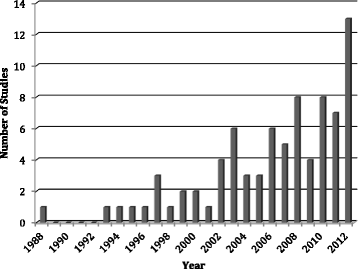A scoping review of biomechanical testing for proximal humerus fracture implants
- PMID: 26223275
- PMCID: PMC4520267
- DOI: 10.1186/s12891-015-0627-x
A scoping review of biomechanical testing for proximal humerus fracture implants
Abstract
Background: Fixation failure is a relatively common sequela of surgical management of proximal humerus fractures (PHF). The purpose of this study is to understand the current state of the literature with regard to the biomechanical testing of proximal humerus fracture implants.
Methods: A scoping review of the proximal humerus fracture literature was performed, and studies testing the mechanical properties of a PHF treatment were included in this review. Descriptive statistics were used to summarize the characteristics and methods of the included studies.
Results: 1,051 proximal humerus fracture studies were reviewed; 67 studies met our inclusion criteria. The most common specimen used was cadaver bone (87%), followed by sawbones (7%) and animal bones (4%). A two-part fracture pattern was tested most frequently (68%), followed by three-part (23%), and four-part (8%). Implants tested included locking plates (52%), intramedullary devices (25%), and non-locking plates (25%). Hemi-arthroplasty was tested in 5 studies (7%), with no studies using reverse total shoulder arthroplasty (RTSA) implants. Torque was the most common mode of force applied (51%), followed by axial loading (45%), and cantilever bending (34%). Substantial testing diversity was observed across all studies.
Conclusions: The biomechanical literature was found to be both diverse and heterogeneous. More complex fracture patterns and RTSA implants have not been adequately tested. These gaps in the current literature will need to be addressed to ensure that future biomechanical research is clinically relevant and capable of improving the outcomes of challenging proximal humerus fracture patterns.
Figures
References
-
- Acevedo DC, Mann T, Abboud JA, Getz C, Baumhauer JF, Voloshin I. Reverse total shoulder arthroplasty for the treatment of proximal humeral fractures: patters of use among newly trained orthopaedic surgeons. J Shoulder Elbow Surg 2014. [Epub ahead of print]. doi: 10.1016/j.jse.2014.01.005. - PubMed
-
- Ockert B, Siebenbürger G, Kettler M, Braunstein V, Mutschler M. Long-term functional outcomes (median 10 years) after locked plating for displaced fractures of the proximal humerus. J Shoulder Elbow Surg 2014. [Epub ahead of print] doi: 10.1016/j.jse.2013.11.009. - PubMed
Publication types
MeSH terms
Grants and funding
LinkOut - more resources
Full Text Sources
Other Literature Sources
Medical
Miscellaneous





